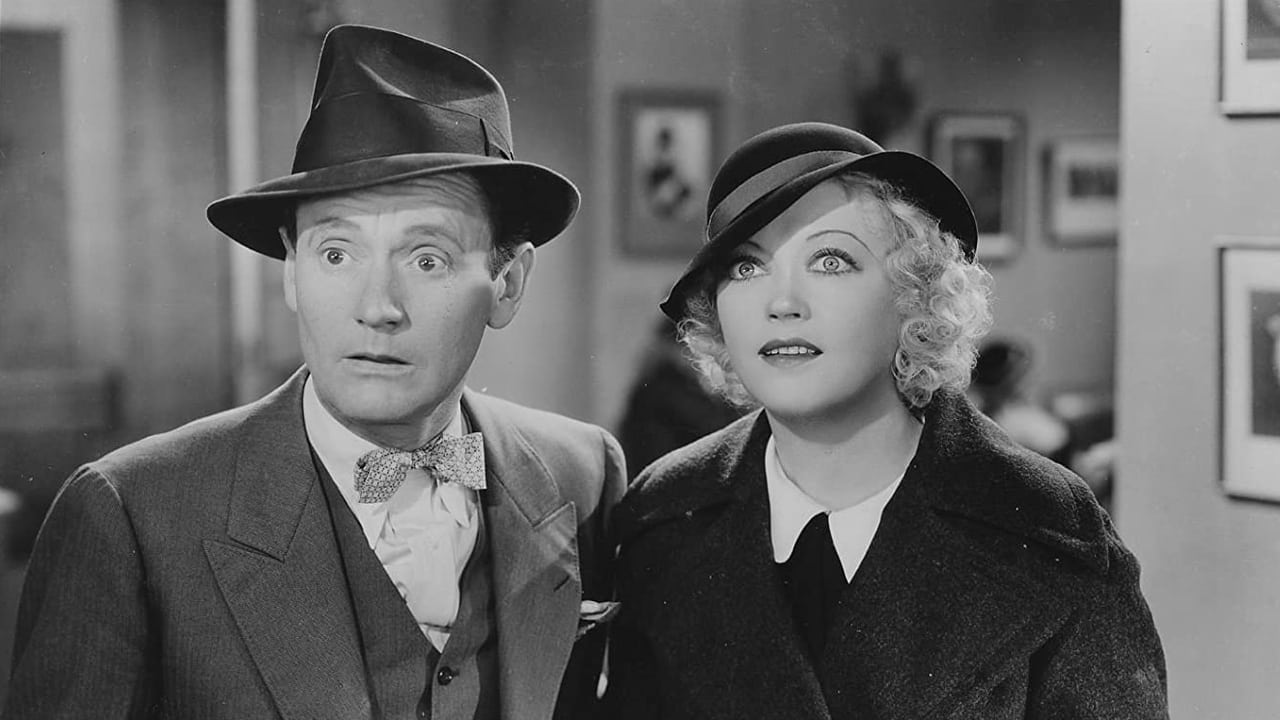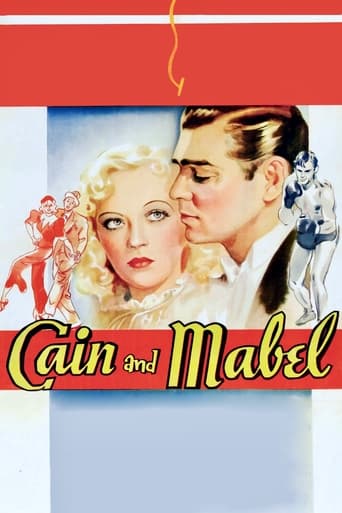



Good story, Not enough for a whole film
The tone of this movie is interesting -- the stakes are both dramatic and high, but it's balanced with a lot of fun, tongue and cheek dialogue.
View MoreThere is, somehow, an interesting story here, as well as some good acting. There are also some good scenes
View MoreThe tone of this movie is interesting -- the stakes are both dramatic and high, but it's balanced with a lot of fun, tongue and cheek dialogue.
View MoreClark Gable and Marion Davies star in a 1936 film, "Cain and Mabel," directed by Lloyd Bacon.Gable plays a talented boxer, Larry Cain. Davies as Mabel O'Dare starts out as a waitress and, after meeting a man (Roscoe Karns) who promises the moon, winds up starring in a Broadway show. The two meet when Cain is trying to get some sleep before a big fight, and Mabel is directly over him at a hotel practicing dance moves. It ends badly, with Cain vowing if he ever meets her again...well, he makes lots of threats.Though they both find success, something is missing in each one of them. Cain can't get fights and business is way down for the show. A publicist decides that to give them glamour and excitement, they need - Love. He plants a story in the papers claiming that the two are having a romance. Since they hate one another, it won't be easy.Even back then, this story was derivative and predictable, but the two stars are delightful. Marion Davies' success has often been laid at the feet of her powerful boyfriend, William Randolph Hearst, but she was a talented actress and comedienne. Gable, despite his gruffness, was very likable, and the two had great chemistry. What a smile Gable had! A couple of things bothered me. You could really tell this wasn't written by a New Yorker. First of all, who in their right mind would take a plane from the theater district in New York, a block or two from the tunnel, to Newark? It's 14 miles!The other thing is that when Mabel refuses to go on stage - where was her understudy? They chased Mabel all over, she is holding up the show, they're vamping the first number - send out the understudy. Uh, didn't happen.Those are minor and no one will care. Fun movie.
View MoreThe story has been done before and since, many times. Two headliners need their careers rehabilitated and decide to join forces for mutual help. They hate each other at first, but then, of course....Of course. Nothing new here. But what separates this picture from other comedies is the staggering amount of one-liners found throughout the story. Virtually every other line of dialogue is a one-line joke. Some are funny, some not so, some corny, some dated. You get on a 'roll', laughter-wise, and it doesn't let up for 90 minutes. This really isn't a screwball comedy but it is funnier than most of them, or any other kind of 30's comedy for that matter.Gable and Davies were very photogenic and very glamorous and I guess that helped to put the picture over at the time. Truth be told, he was better than she was. Marion Davies was a very unnatural actress with an unmodulated voice and a reviewer above hit the nail on the head by saying she was no Carole Lombard. Walter Catlett, Roscoe Karns and, especially, Ruth Donnelly, helped out immensely, as did the excellent musical score. Lots of good songs in the big production number toward the end of the picture."Cain And Mabel" is a forgotten gem nowadays, and I can't figure out why. If you haven't seen it and you've read this far, you should. Otherwise you would miss the best 30's comedy that hardly anyone knows about.
View MoreI really loved Marion Davies in her silent films, but I've never liked her talking pictures that much as a whole. In this case, the plot is plucked from about a half dozen other 30's films that came before it, but the film does have Clark Gable going for it as well as those terrific contract Warner Brothers players.The premise is rather unbelievable. Waitress Mabel O'Dare is fired from her job for feeding a hungry unemployed publicist. He decides to help Mabel out by getting her a job in a Broadway show. The leading man pretends to be the show's producer as a gag, and tells Mabel she has the lead without even auditioning her. Unbelievable point number one - Mabel believes him. Unbelievable point number two - when she shows up and finds out she has no job, not even a spot in the chorus, the leading man and the producer feel so bad for her they do give her the lead, even though she's never danced or sung professionally before.All of this I could live with, but then you have prizefighter Larry Cain (Clark Gable) and Mabel hating each other throughout two-thirds of the film for a multitude of mutual insults and injuries to one another. However, a single home-cooked pork chop by Mabel and her revelation to Larry that she used to be a waitress has him proposing inside of ten minutes? This is too much to swallow even for one of the screwball comedies of the thirties.Finally there is the most tiresome part of the film, and that is the musical portion. There are two numbers that try to copy Busby Berkeley to some extent, but dance director Bobby Connelly doesn't seem to understand that you can't top Berkeley simply by building a taller set and a larger crane. Your numbers have to have some substance. The whole thing is haunted by the ghosts of the largely failed musical films of the late 20's and very early 30's with tableaux and spectacles that are just plain boring.I'd say it's almost a toss of a coin as to whether or not this one is worth your time. I gave it a 6/10 mainly because I'm such a sucker for those Warner Brothers films of the 1930s.
View MoreBy this point in time, Marion Davies has received an honest evaluation as a performer: far from being a hopeless, no-talent Susan Alexander who appeared before the public solely through the wealth and ego of Hearst, she was nevertheless overmatched in many of her roles, displaying the abilities of a competent supporting player if the material were not too challenging.Casting her in CAIN AND MABEL was a mistake. She has no discernible flair for comedy, her timing being awkward, her gestures and facial expressions being studied, rather than natural. If in fact it is her own singing voice that we hear, its lack of expressiveness is thankfully limited to a few bars. Being a former hoofer, Davies might be expected to acquit herself with some distinction as a featured dancer, but in fact in her one extended number here, her nimble and stylish male partner, Sammy White, rather than making her look good, illustrates just how numerous her limitations were. Further along, there is a balletic production number in which she poses gracefully in the close and medium shots, while the challenging movements and steps are all photographed in long shots, obviously performed by a double.The story is trite and flimsy - not at all the screwball comedy it was clearly intended to be. Roscoe Karns and Allen Jenkins perform their characteristic screen roles, while Walter Catlett and Ruth Donnelly are unfortunately kept somewhat under wraps. Caught in the midst of all this - but doing his earnest best, as usual - is Clark Gable.Postscript: Is it a fact that Hearst issued an order that Miss Davies was not to be kissed on the lips? In the half-dozen or so romantic clinches that follow the leading players' confession of their mutual love, Gable kisses her on the cheek and on the chin, getting as close to her mouth as possible, but clearly off-target.....like a number of other things in this forgettable picture.
View More